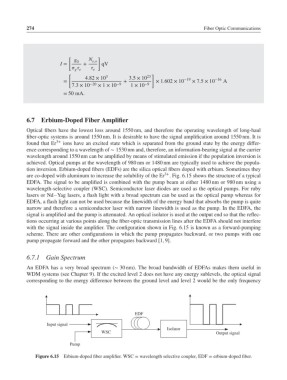Page 293 - Fiber Optic Communications Fund
P. 293
274 Fiber Optic Communications
[ ]
g 0 N e,o
I = + qV
e
g e
[ 3 23 ]
4.82 × 10 3.5 × 10 −19 −16
= + × 1.602 × 10 × 7.5 × 10 A
7.3 × 10 −20 × 1 × 10 −9 1 × 10 −9
= 50 mA.
6.7 Erbium-Doped Fiber Amplifier
Optical fibers have the lowest loss around 1550 nm, and therefore the operating wavelength of long-haul
fiber-optic systems is around 1550 nm. It is desirable to have the signal amplification around 1550 nm. It is
found that Er 3+ ions have an excited state which is separated from the ground state by the energy differ-
ence corresponding to a wavelength of ∼ 1530 nm and, therefore, an information-bearing signal at the carrier
wavelength around 1550 nm can be amplified by means of stimulated emission if the population inversion is
achieved. Optical pumps at the wavelength of 980 nm or 1480 nm are typically used to achieve the popula-
tion inversion. Erbium-doped fibers (EDFs) are the silica optical fibers doped with erbium. Sometimes they
3+
are co-doped with aluminum to increase the solubility of the Er . Fig. 6.15 shows the structure of a typical
EDFA. The signal to be amplified is combined with the pump beam at either 1480 nm or 980 nm using a
wavelength-selective coupler (WSC). Semiconductor laser diodes are used as the optical pumps. For ruby
lasers or Nd–Yag lasers, a flash light with a broad spectrum can be used as the optical pump whereas for
EDFA, a flash light can not be used because the linewidth of the energy band that absorbs the pump is quite
narrow and therefore a semiconductor laser with narrow linewidth is used as the pump. In the EDFA, the
signal is amplified and the pump is attenuated. An optical isolator is used at the output end so that the reflec-
tions occurring at various points along the fiber-optic transmission lines after the EDFA should not interfere
with the signal inside the amplifier. The configuration shown in Fig. 6.15 is known as a forward-pumping
scheme. There are other configurations in which the pump propagates backward, or two pumps with one
pump propagate forward and the other propagates backward [1, 9].
6.7.1 Gain Spectrum
An EDFA has a very broad spectrum (∼ 30 nm). The broad bandwidth of EDFAs makes them useful in
WDM systems (see Chapter 9). If the excited level 2 does not have any energy sublevels, the optical signal
corresponding to the energy difference between the ground level and level 2 would be the only frequency
EDF
Input signal
Isolator
WSC Output signal
Pump
Figure 6.15 Erbium-doped fiber amplifier. WSC = wavelength selective coupler, EDF = erbium-doped fiber.

